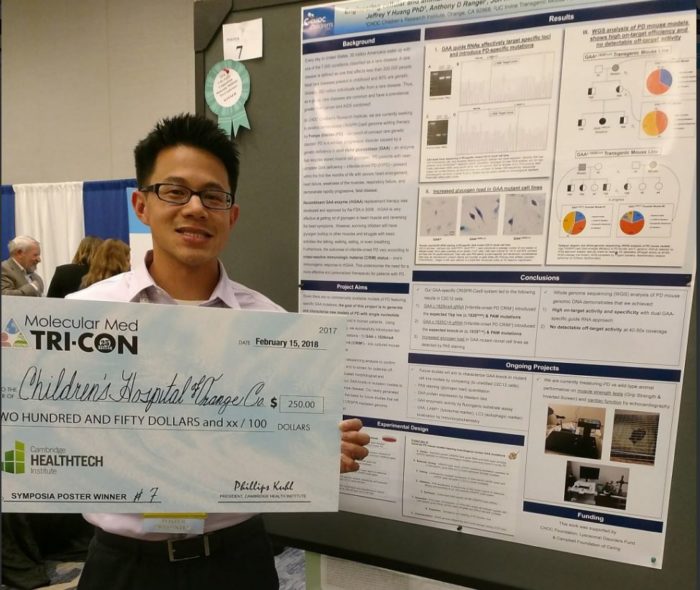Jeffrey Huang, Ph.D., a research scientist at CHOC Research Institute whose scientific interests include applying innovative molecular biology techniques to the treatment of rare pediatric disorders, was recently honored at the Molecular Medicine Tri-Conference.
Considered one of the world’s leading international events in the field of drug discovery, development and diagnostics, the conference attracts more than 3,000 innovative thinkers and thought leaders in biotech, pharma and academia from around the world.
In addition to serving as a guest speaker at the conference, Dr. Huang was honored with the “Best Poster” award for his presentation, “Engineering cellular and animal models of rare disease using CRISPR-Cas9 genome editing.” In this Q & A, he shares insight about his research and its promise for the future.
What inspires you to focus on rare pediatric disorders, such as Pompe disease?
As a translational research scientist, I am committed to bringing the best scientific research has to offer to the clinic. My decision to join CHOC Research Institute was fueled by a desire to address the lack of alternative treatment options for CHOC patients and families affected by rare pediatric disorders. Over 30 million Americans – nearly 1 in 10 people – suffer from one of the 7,000 conditions classified as a rare disease. Many rare disorders often lead to progressively debilitating and sometimes fatal outcomes in infants and children. Unfortunately, there are no cures for most rare diseases; if existent, current therapy only attenuates or slows disease progression. My primary research focus is to evaluate and develop CRISPR genome editing therapeutics to address deficiencies of existing treatment for rare pediatric disorders such as Pompe disease.

What are you seeking to accomplish with your research?
Currently, I lead a project to develop personalized CRISPR genome editing therapeutics for Pompe disease – our proof-of-concept rare pediatric disorder. Pompe disease is a progressive cardiac and skeletal myopathy lysosomal storage disorder (LSD) which, despite intravenous doses of recombinant enzyme 40 times that of other LSD treatments, results in the deterioration of affected patients’ muscle strength. With over 15 years of experience in advanced molecular, cellular, and developmental biology, I have outlined the following strategy to evaluate the therapeutic efficacy and safety of CRISPR genome editing for Pompe disease.
The specific aims of our project are:
1) To generate, via CRISPR-Cas9 technology, animal models of Pompe disease that bear mutations homologous to those that cause human Pompe disease
2) To fully evaluate and validate the animal models generated to ensure molecular, biochemical, histopathological and functional analogy to human Pompe disease
3) To develop specific CRISPR genome editing/delivery systems correcting mutations in validated models of Pompe disease
4) To assess molecular, biochemical, histopathological and functional efficacy as well as safety of CRISPR genome correction in our Pompe disease animal models
I am excited to report that within the past year we have successfully demonstrated that our Pompe disease-specific CRISPR genome editing strategy has produced the desired mutations in cultured cells. Following this pilot experiment, we microinjected our Pompe disease CRISPR reagents into fertilized mouse zygotes to produce the first CRISPR-generated animal model at CHOC (Specific Aim 1). We are currently expanding this new animal model of Pompe disease and will perform the appropriate tests on the expanded cohort to confirm analogy to human Pompe disease (Specific Aim 2).
Our newly generated Pompe animal models will form the basis for future studies that will test the efficacy and safety of CRISPR-mediated genome correction in an in vivo context.
What other projects are in the works?
Future work will focus on evaluating which CRISPR delivery strategy works best to correct Pompe disease mutations in affected tissue (Specific Aim 3) and assessing the efficacy and safety of genome correction in our animal model (Specific Aim 4). Our application of CRISPR technology to Pompe disease will form the basis for future personalized genome editing studies and model the appropriate safeguards that need to be taken prior to testing CRISPR genome editing therapies in a clinical setting.




